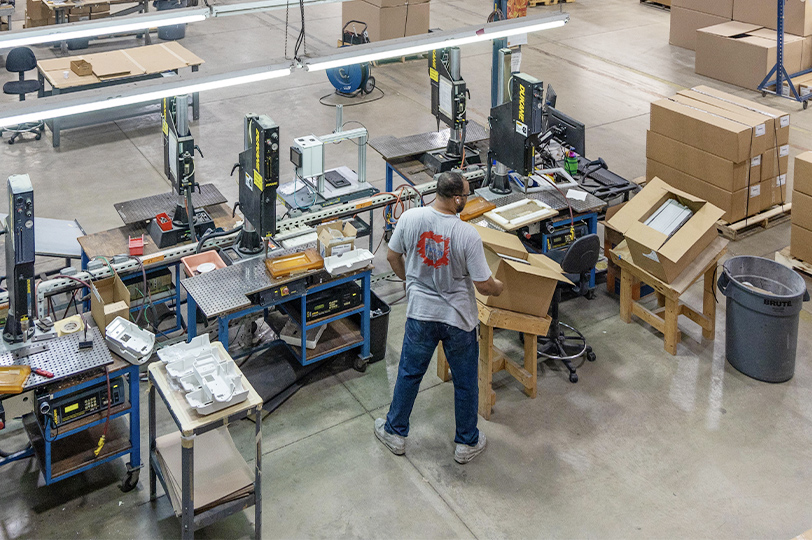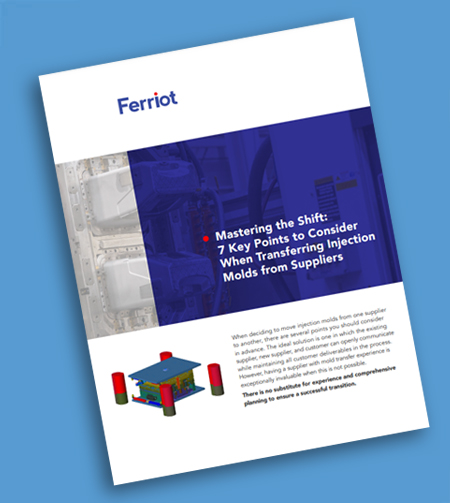Timely Delivery of Injection Molded Parts
From safety helmets to children’s toys, or syringe barrels to ATM’s, the universe of parts that rely on injection molding keeps growing. The injection molding process gives companies the capability to create complex shapes and to incorporate vibrant colors or intricate details into a final product, all for a cost-effective price. However, the process only remains cost-effective until deliveries get bogged down and dates are missed, stalling critical production lines and impacting profitability.
The global plastic injection molding market is currently on a trajectory of consistent growth, with a projected compound annual growth rate (CAGR) of 5.1% through 2027.
As the demand for injection molded parts continues to surge, it becomes increasingly vital to optimize production processes and ensure timely delivery of injection molded parts. This article explores the key factors that enhance injection molding efficiencies, maintain production schedules and help manufacturers devise strategies for sustained profitability.
Optimize Injection Molder Production Schedules
Because injection molding is perfect for large volume production, one must understand the best way to optimize purchases for production needs. Know your EAU’s. Part cost will drop when production run quantities are higher.
Many injection molders will provide quantity breaks based upon purchase quantities. Can you order more parts at fewer intervals? Are you maximizing warehouse storage by ordering full pallet quantities? What are your safety stock levels? Are the parts small or large? How much room do you need to store them?
Working with your team to get a good forecast will allow you to prepare to have stock on hand when needed and give you the ability to handle any drop-in orders. Sharing your forecast with your injection molding partner is critical. Good consistent communication with regards to your forecast is vital when it comes to urgent order needs as well as slow sales cycles. Your injection molder should work with you as your needs change.
Understanding Resin Supply Lead Times
Managing lead times for resin supply are particularly critical for injection molders, as they’re tied intricately to the availability of diverse types of resin. The lead times for resins will vary significantly based on factors including:
- Resin sophistication
- Supplier reliability
- Purchase volumes and ability to buy direct or through a distributor
For example, some commodity resins are available from distributors in as little as four days, while specialty resins might have substantial lead times that stretch up to eight weeks or more. This wide variance in availability along with MOQ’s can significantly impact production schedules and customer commitments. This is easier to factor into a project that has a preset schedule for repeat orders or order fulfillment. Resin availability more keenly impacts custom injectable parts.
Resin stocking agreements and proactive inventory management can help with repeat orders, such as Kanban or an ERP (Enterprise Resource Planning) alert system that lets a company know it is at minimum resident inventory or injection part inventory. These alerts or project management systems mitigate the potential disruption of project timelines by triggering an order that factors anticipated long lead times into consideration.
In today’s dynamic landscape, lead times for resin are not static, and what’s easily available today may not be as prevalent tomorrow. Companies can best manage lead times and expectations by maintaining effective, open communication with the injection molders and related suppliers.
The New Transportation/Logistics Landscape
Before we talk about transportation, lets talk about the logistics of product assembly and what happens to your injection molded parts. Do they require additional work such as painting or assembly? If so, find an injection molder that provides the value-added, secondary services that you need.
If you are able to have your parts painted, logo added or assembled by the injection molder you will save time because it can be done in one place instead of being shipped to someone else to do the work. Custom injection molders who provide these services are expert at finding ways to save time on secondary services and can sometimes even find a way to complete the work during production in the injection molding cell.
Consider having sub-assemblies shipped to the final manufacturing location. The time and money saved by shortening the production cycle and eliminating another shipment to another location can go direct to the bottom line. Now let’s talk about transportation.
Transportation/logistics is a critical component when looking to maintain project delivery commitments. Obviously, transportation has always been a factor in parts delivery. However, the landscape changed and altered in ways during the pandemic and with several recent significant company bankruptcies, leaving behind issues that shipping and supply chain managers are forced to manage on a daily basis.
Many customers have historically managed their own freight arrangements, and these companies could rely on the availability of reliable transportation services. But with the recent shutdowns of Yellow Freight and others, the entire logistics network is experiencing ripple effects as deliveries are parceled out to other carriers. These remaining companies already were dealing with tight schedules. In addition, costs have risen, and the transportation equation has become more complex.
In the past, a phone call in the morning could trigger a same-day delivery. Now, customers might need to anticipate a delivery that could take several days. This shift prompts questions about the current state of the freight industry and its challenges.
Even when products are finished and have reached the supplier’s dock, this arrival doesn’t guarantee a freight company’s availability for pick up. All these scenarios underline the critical need for a comprehensive approach and different strategies to factor transportation into project timelines.
First, many companies have expanded their carrier bases or partnered with logistics companies to manage shipping needs. This can help secure better rates, improve performance and increase flexibility for deliveries.
Secondly, companies can find value in building good relationships with their key transportation providers. Regular weekly shipments or “milk runs” can be commonplace. Depending on the circumstance you may have your own vehicles for these as well. As companies work on relationships with business partners throughout the supply chain, make the effort to include transportation providers within this group.
Conclusion
Partnering with an experienced and innovative injection molding specialist like Ferriot can make a substantial difference in optimizing timely delivery of injection molded parts. With a deep understanding of resin supply dynamics, efficient inventory management systems and a network of reliable transportation partners, Ferriot offers a comprehensive solution to project timeline challenges faced by so many of our customers.
Our commitment to open communication and collaborative problem-solving ensures that your projects stay on track and your timelines are met. By leveraging our expertise and resources, you can benefit from reduced lead times, increased efficiency and, ultimately, improved profitability.
Ferriot is your trusted ally in the pursuit of timely, high-quality injection molded parts, regardless of the complexity or scale of your manufacturing needs. Our team is ready to collaborate with you on your next project or repeat order. Give us a call. Or, to learn more about resin selection to help with timely project delivery, take a look at Ferriot’s Injection Molding Resin Selection Workbook for more information.



